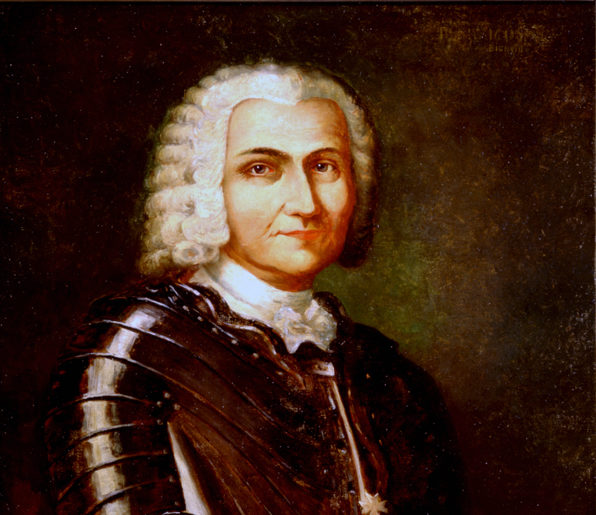Natchitoches Settlement
The Natchitoches settlement, founded in 1714, is the oldest in the Louisiana Territory.

Louisiana State Museum.
Color reproduction of a 1910 oil painting by Rudolph Bohunek of Jean Baptiste Le Moyne, Sieur de Bienville.
Natchitoches, the oldest European settlement in present-day Louisiana, was founded by the French explorer Louis Juchereau de St. Denis in 1714. Named after a local Native American group, Natchitoches remained an important colonial outpost during the French, Spanish, and American periods in Louisiana history.
St. Denis accompanied Pierre Le Moyne, Sieur d’Iberville, and Jean-Baptiste Le Moyne, Sieur de Bienville, on their first voyage to Louisiana in 1699. He remained in the colony exploring the areas of the lower Mississippi River Valley, including the Red and Ouachita rivers. During these travels he encountered and befriended the three Natchitoches tribes residing there—the Doustionis, Yatasis, and Natchitoches—in addition to the Caddo Confederacies. An increasing number of raiding attacks by the Chickasaws and a devastating crop failure threatened the Caddos, so in 1705 St. Denis assisted them in relocating from their native grounds on the Red River to live among the Acolapissa on the Pearl River north of Lake Pontchartrain.
The French Crown relinquished control of the Louisiana colony in 1712 and Antoine Crozat became the sole proprietor of the colony. Crozat named Antoine de la Mothe, Sieur de Cadillac, governor of the colony and instructed him to seek new avenues of trade and wealth for the fledgling colony. Shortly after assuming his post, Cadillac received a letter from a Spanish Franciscan missionary, Father Francisco Hidalgo, requesting help with his failed mission to the Caddos. Hidalgo, frustrated by the lack of support from Spanish authorities, appealed to Cadillac to help him convert the Caddos to Catholicism, either by building a new mission with French assistance or by having the French apply pressure on the Spanish to send aid for the revival of the mission in East Texas. Cadillac saw this situation as an opportunity to establish a foothold in the region and to instigate trade with the Spanish in the area. Sanctions made direct trade between the Spanish and French illegal; however, Cadillac felt that necessity, proximity, and isolation would trump this legal hurdle.
In response to Crozat’s dictate and Hidalgo’s offer, Cadillac ordered St. Denis to establish a new trading route with the Spanish and Indian Nations in the western part of the territory. As a result, St. Denis asked the Natchitoches if they wished to return to their native grounds and help establish a trading post in the vicinity, and they agreed. Upon learning that the Natchitoches would be leaving, the Acolapissa attacked them, killing seventeen men and capturing fifty women and children. St. Denis vowed revenge, but no evidence exists that it occurred.
When the Natchitoches arrived at their former site on the Red River, they found the Doustionis occupying it. St. Denis skillfully convinced both tribes to share the land and live together. In addition, he persuaded them to help build the fort, which included living quarters for the French and warehouses for the trading goods. This post, called Fort St. Jean Baptiste des Natchitoches, was located on an island in the middle of the Red River. The fort, together with the nearby native settlements of the Natchitoches, Doustionis, and Yatasis, formed the basis of the first settlement at Natchitoches.
St. Denis did not stay long at the new post but traveled south to negotiate trade agreements with the Spanish. He was briefly incarcerated by the Spanish but eventually returned north to Natchitoches in 1716 and helped the Spanish to reoccupy East Texas. Though it was still illegal for the French and Spanish to trade directly with each other, St. Denis reasoned that enforcement of this law would be lax given the great distance from the nearest Spanish establishment (Presidio San Juan Bautista near the Rio Grande) and the immediate need for goods in the Spanish missions. Thus, in anticipation of trading opportunities with the Spanish as well as with Native Americans, St. Denis travelled to Mobile and purchased 60,000 livres worth of trade goods. However, the Spaniards—wanting to stop or at least check French expansion into their territory—established a mission fifteen miles west of Natchitoches in the Adaes Indian Village in addition to five other strategically placed missions.
In 1717 Crozat surrendered control of the colony to the Company of the Indies. The French government appointed Bienville governor and named Philippe Blondel commandant of the Natchitoches post. Bienville also sent one sergeant and six soldiers to the fort. Blondel’s tenure as commandant was short, however, and in 1719, St. Denis not only became commander of the fort but also received jurisdiction over the entire Red River Valley. The population grew slowly over the next several years. In 1722 the civilian population in Natchitoches was only thirty-four and the slave population twenty. Four years later, the population of these two groups grew to 102 and 32 people, respectively. The total population, including soldiers, grew from 112 in 1722 to 160 in 1726.
St. Denis retained the post of commandant until 1744. He relinquished his command with plans of moving his family to New Spain, but died later that same year. The French authorities denied St. Denis’s request, and his family remained in Natchitoches after his death.
